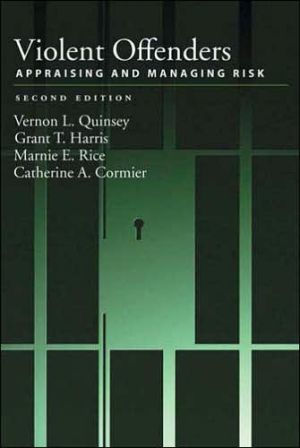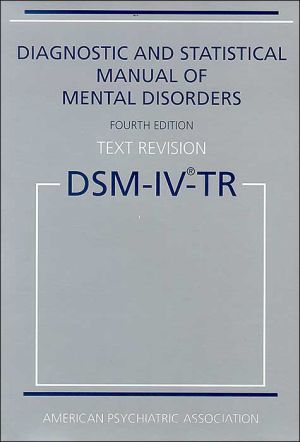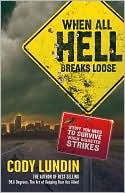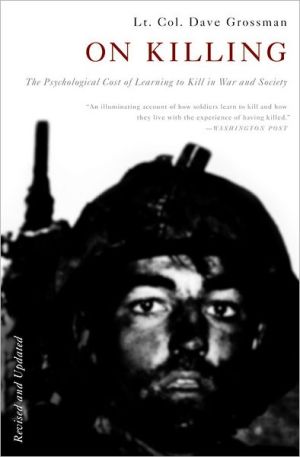Violent Offenders: Appraising and Managing Risk
Must we continue to endure the return of violent offenders to the community, a situation that seems to result in more death and destruction? Arguing from the notion that community risk management can be improved by combining what has already known about the prediction of violence, the study of decision making and clinical judgment, and the literature on treatment outcomes and program evaluation, the authors report on a sustained 35-year program of research in Canada. They give an historical...
Search in google:
Must we continue to endure the return of violent offenders to the community, a situation that seems to result in more death and destruction? Arguing from the notion that community risk management can be improved by combining what has already known about the prediction of violence, the study of decision making and clinical judgment, and the literature on treatment outcomes and program evaluation, the authors report on a sustained 35-year program of research in Canada. They give an historical perspective, previous research on prediction, methods and measurement, clinical approaches, reviews of a new generation of follow-up studies on mentally disordered offenders, fire setters and sex offenders, reviews of violence prediction instruments (the actuarial approach and its criticism) and describe altering the risk of violence through treatment and management. They include information about the Violence Risk Appraisal Guide and the Sex Offender Risk Appraisal Guide and other instruments for assessing and managing violent offenders in and out of your neighborhood. Annotation ©2006 Book News, Inc., Portland, OR Doody Review Services Reviewer:Gary B Kaniuk, Psy.D.(Cermak Health Services)Description:This book describes how to assess and manage risk in dealing with violent offenders. The authors encourage the reader to consider combining three areas: the prediction of violence, the study of decision making and clinical judgment, and the literature on treatment outcomes and program evaluation for improved community risk management. The book discusses both the VRAG (Violence Risk Appraisal Guide) and the SORAG (Sex Offender Risk Appraisal Guide). The first edition of this book was published in 1999.Purpose:According to the authors, "this book reports on a sustained program of research that began 35 years ago." They continue, "Our primary concern in this book is with the criminal violence of both mentally disordered offenders and criminal inmates, not with politically inspired terrorism, civil war, or war between states." And further: "This book concerns persons whose histories of criminal violence raise serious societal concerns about whether they will commit further violent acts." And finally: "There has been substantial change in the field of risk assessment in the 7 years since the first edition of this book appeared. Most important, the empirical literature on the prediction of recidivism is now much larger and richer than it was.Audience:The book is intended for all legal and psychological professionals and policymakers who participate in decisions on whether and under what circumstances violent offenders should be released, and how they should be managed. I would add that graduate students in forensic psychology/psychiatry programs would benefit greatly as well. Features:The four sections of the book cover historical and methodological context, a new generation of follow-up studies, development of violence prediction instruments, and altering the risk of violence and conclusions. The authors have included a tremendous amount of research, much of it coming from probably the most widely studied maximum security psychiatric facility in the world (Oak Ridge Division of the Mental Health Centre, Penetanguishene in Ontario, Canada). The research includes mentally disordered offenders, fire setters, and sex offenders. I thoroughly enjoyed chapter 9 on criticisms of actuarial risk assessment. Here, 20 arguments are refuted with wonderful explanations. The appendixes contain a tremendous amount of information on both the VRAG and SORAG. The authors have compiled a book that is easy to read, practical, and provides much information on risk assessment. There is no fluff here.Assessment:This is the book to have if you want to learn about risk assessment from those who are actually doing it. Its well written chapters are extremely practical. The book implores the reader to consider using actuarial prediction tools. The authors suggest that clinical judgment is not enough, not here in the 21st century, with the burgeoning amount of research available to clinicians. I have not read a book comparable to this one. The second edition justifies replacing the first due to the significant amount of new research since 1999.
Ch. 1Historical perspective11Ch. 2Previous research on prediction33Ch. 3Methods and measurement49Ch. 4Clinical judgment61Ch. 5Mentally disordered offenders85Ch. 6Fire setters115Ch. 7Sex offenders131Ch. 8Actuarial prediction of violence155Ch. 9Criticisms of actuarial risk assessment197Ch. 10Treatment and management227Ch. 11Conclusions267App. AViolence risk appraisal guide (VRAG)App. BSex offender risk appraisal guide (SORAG)App. CNormative data on the distribution of violence risk appraisal guide (VRAG) and sex offender risk appraisal guide (SORAG) scoresApp. DTechnical questions about the violence risk appraisal guide (VRAG) and the sex offender risk appraisal guide (SORAG)App. ECormier-Lang system for quantifying criminal historyApp. FGuidelines for the compilation of a psychosocial history suitable for risk appraisalApp. GSample psychosocial history suitable for use in scoring the violence risk appraisal guide (VRAG) and the sex offender risk appraisal guide (SORAG)App. HScoring the violence risk appraisal guide (VRAG) from a psychosocial historyApp. IScoring the sex offender risk appraisal guide (SORAG) from a psychosocial historyApp. JActuarial risk appraisal report for an offenderApp. KSample psychosocial history and scoring of the violence risk appraisal guide (VRAG) for a psychiatric offenderApp. LProblem identification checklist (file version)App. MProximal risk factor scaleApp. NDynamic risk appraisal scaleApp. OCross-sectional Oak Ridge statistics over 35 years
\ Reviewer: Gary B Kaniuk, Psy.D.(Cermak Health Services)\ Description: This book describes how to assess and manage risk in dealing with violent offenders. The authors encourage the reader to consider combining three areas: the prediction of violence, the study of decision making and clinical judgment, and the literature on treatment outcomes and program evaluation for improved community risk management. The book discusses both the VRAG (Violence Risk Appraisal Guide) and the SORAG (Sex Offender Risk Appraisal Guide). The first edition of this book was published in 1999.\ Purpose: According to the authors, "this book reports on a sustained program of research that began 35 years ago." They continue, "Our primary concern in this book is with the criminal violence of both mentally disordered offenders and criminal inmates, not with politically inspired terrorism, civil war, or war between states." And further: "This book concerns persons whose histories of criminal violence raise serious societal concerns about whether they will commit further violent acts." And finally: "There has been substantial change in the field of risk assessment in the 7 years since the first edition of this book appeared. Most important, the empirical literature on the prediction of recidivism is now much larger and richer than it was."\ Audience: The book is intended for all legal and psychological professionals and policymakers who participate in decisions on whether and under what circumstances violent offenders should be released, and how they should be managed. I would add that graduate students in forensic psychology/psychiatry programs would benefit greatly as well. \ Features: The four sections of the book cover historical and methodological context, a new generation of follow-up studies, development of violence prediction instruments, and altering the risk of violence and conclusions. The authors have included a tremendous amount of research, much of it coming from probably the most widely studied maximum security psychiatric facility in the world (Oak Ridge Division of the Mental Health Centre, Penetanguishene in Ontario, Canada). The research includes mentally disordered offenders, fire setters, and sex offenders. I thoroughly enjoyed chapter 9 on criticisms of actuarial risk assessment. Here, 20 arguments are refuted with wonderful explanations. The appendixes contain a tremendous amount of information on both the VRAG and SORAG. The authors have compiled a book that is easy to read, practical, and provides much information on risk assessment. There is no fluff here.\ Assessment: This is the book to have if you want to learn about risk assessment from those who are actually doing it. Its well written chapters are extremely practical. The book implores the reader to consider using actuarial prediction tools. The authors suggest that clinical judgment is not enough, not here in the 21st century, with the burgeoning amount of research available to clinicians. I have not read a book comparable to this one. The second edition justifies replacing the first due to the significant amount of new research since 1999.\ \








